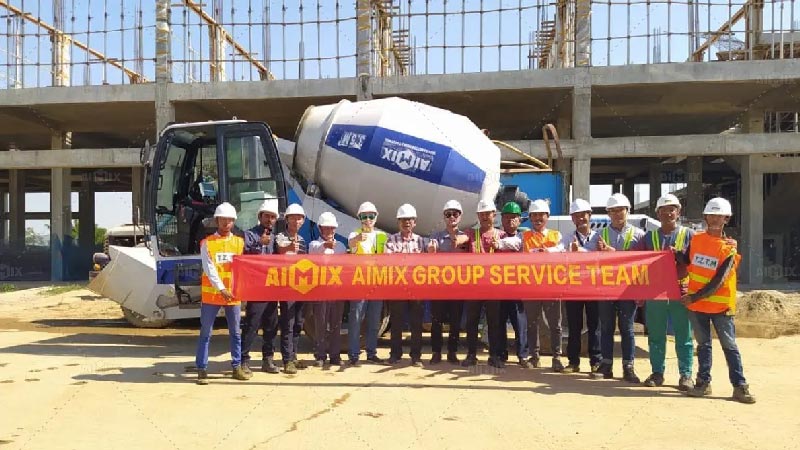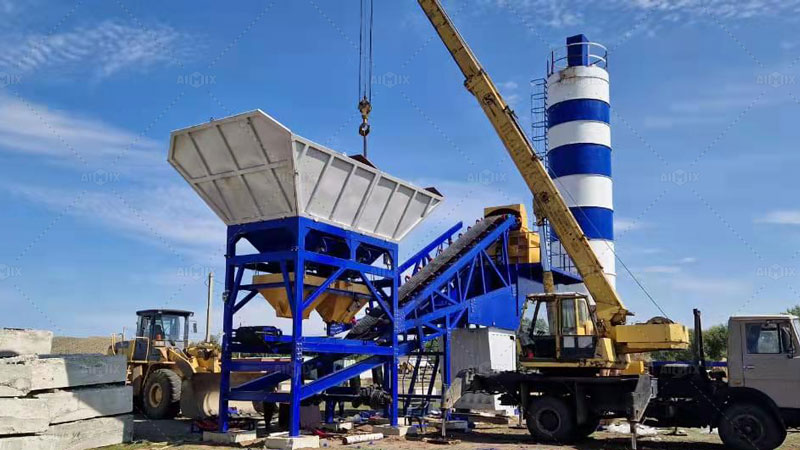When selecting equipment for concrete production, two commonly used options are the self-loading concrete mixer and the mobile concrete plant. Both serve distinct purposes and are designed to meet different project needs. Choosing the right one depends on factors such as mobility, production capacity, cost, and efficiency. This article explores the key differences between these two types of concrete equipment to help you make an informed decision.
What is a Self-Loading Concrete Mixer?
A self-loading concrete mixer(auto hormigonera) is a highly versatile machine that combines the functions of a loader, mixer, and concrete transporter. It is designed to produce concrete on-site, making it an excellent choice for projects that require mobility and efficiency.
Key Features of a Self-Loading Concrete Mixer
- Automatic Material Loading: Equipped with a hydraulic shovel, the mixer can load raw materials such as cement, sand, and aggregates without additional equipment.
- On-Site Mixing: Concrete is mixed directly at the construction site, eliminating the need for transportation from a batching plant.
- 360-Degree Rotation: Many models have a rotating drum that allows concrete to be poured in different directions without repositioning the machine.
- Enhanced Maneuverability: Self-loading mixers are compact and capable of navigating rough terrains and confined job sites.
- Lower Operating Costs: Reduces labor and transportation costs, making it an economical solution for smaller projects.

What is a Mobile Concrete Plant?
A mobile concrete plant, also known as a portable batching plant(planta de concreto movil), is designed for efficient concrete production at temporary or remote construction sites. Unlike a stationary plant, it can be easily transported and installed at different locations.
Key Features of a Mobile Concrete Plant
- High Production Capacity: Capable of producing large volumes of concrete per hour, making it ideal for infrastructure and commercial projects.
- Precise Batching: Uses advanced control systems to ensure accurate mixing ratios for consistent concrete quality.
- Modular Design: Components such as cement silos, aggregate bins, and conveyor belts can be transported separately and assembled on-site.
- Quick Installation: Most mobile plants can be set up within a few days, reducing downtime between project phases.
- Efficient Bulk Production: Designed to handle large quantities of raw materials, ensuring a steady concrete supply.

Key Differences Between a Self-Loading Concrete Mixer and a Mobile Concrete Plant
1. Mobility and Flexibility
A self-loading concrete mixer is a highly mobile unit designed for frequent relocation. It is ideal for small projects in remote locations or construction sites with limited space. In contrast, a mobile concrete plant requires installation and setup before operation but provides higher efficiency once established.
2. Production Capacity
Mobile concrete plants are designed for large-scale production, with the ability to produce up to hundreds of cubic meters of concrete per hour. A self-loading mixer(auto hormigonera en Chile), however, has a lower production capacity, typically ranging from 1 to 4 cubic meters per batch, making it more suitable for smaller projects.
3. Automation and Efficiency
Both types of equipment offer automation, but a mobile concrete plant provides more precise control over the mixing process. It ensures uniform batching and can integrate with computerized control systems. Self-loading mixers, while automated in loading and mixing, are less precise in batch consistency but provide the advantage of immediate on-site mixing.
4. Cost Considerations
A self-loading concrete mixer generally has a lower initial investment compared to a mobile concrete plant. It also reduces labor costs since it requires fewer operators. However, for high-volume production, a mobile concrete plant is more cost-effective as it can handle bulk materials efficiently, reducing overall production expenses.
5. Suitability for Different Projects
- Self-Loading Concrete Mixer: Best suited for small to medium-sized projects, remote job sites, road construction, and repair work.
- Mobile Concrete Plant: Ideal for large infrastructure projects such as bridges, highways, and commercial buildings where a high and consistent concrete supply is needed.
Advantages and Disadvantages of Each Option
Advantages of a Self-Loading Concrete Mixer
- Increased flexibility and mobility for on-site mixing.
- Lower upfront cost and reduced transportation expenses.
- Operates efficiently in areas with limited infrastructure.
- Requires minimal setup time before operation.
Disadvantages of a Self-Loading Concrete Mixer
- Limited production capacity compared to a mobile concrete plant.
- Less precise batching compared to a plant with automated systems.
Advantages of a Mobile Concrete Plant
- High production output suitable for large-scale projects.
- Accurate batching and consistency in concrete quality.
- Ability to integrate with modern control systems for efficiency.
Disadvantages of a Mobile Concrete Plant
- Requires more space for installation and setup.
- Higher initial investment and transportation costs for moving between sites.
Which One Should You Choose?
The choice between a self-loading concrete mixer(una autohormigonera Bolivia) and a mobile concrete plant depends on your project’s scale, location, and budget. If your priority is flexibility and on-site mixing, a self-loading mixer is the ideal option. However, if you require large-scale production with consistent batching, a mobile concrete plant is the better choice.
Conclusion
Both self-loading concrete mixers and mobile concrete plants play crucial roles in modern construction. The right choice depends on the specific requirements of your project. For small to medium-sized jobs where mobility is key, a self-loading mixer provides efficiency and convenience. For larger projects requiring high-volume production, a mobile concrete plant ensures consistent quality and bulk output. Understanding these differences will help you make a well-informed decision that optimizes efficiency and cost-effectiveness for your construction needs.